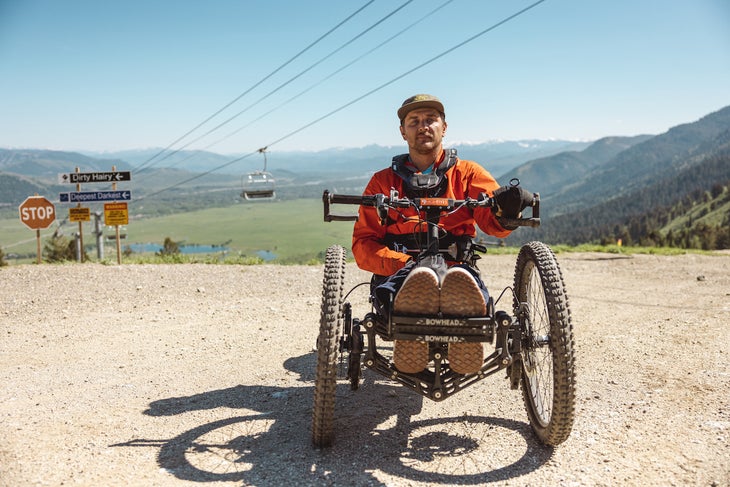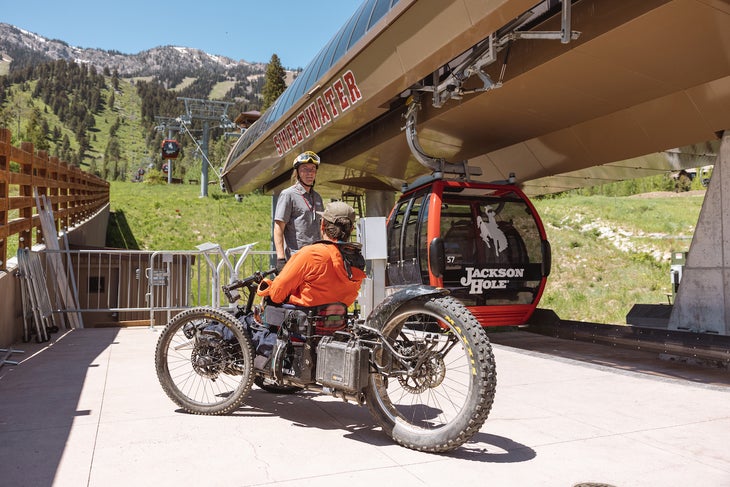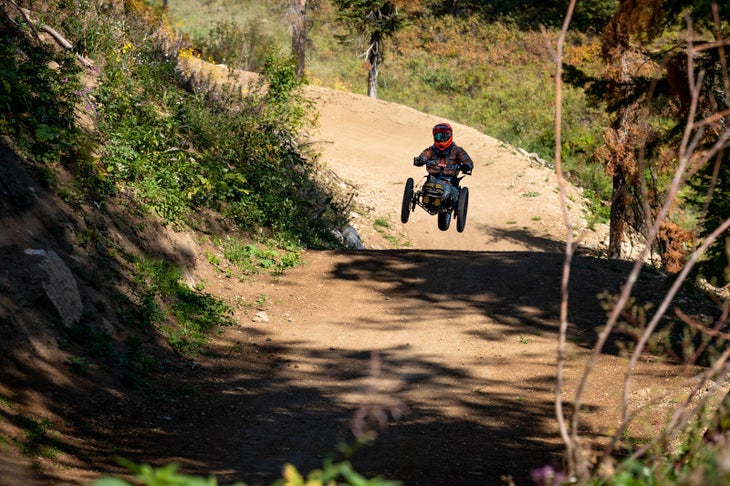Products You May Like
Get full access to Outside Learn, our online education hub featuring in-depth fitness, nutrition, and adventure courses and more than 2,000 instructional videos when you sign up for Outside+
Sign up for Outside+ today.
Flying downhill on a mountain bike is one of the few off-snow activities that delivers the same feeling of pure joy as sliding on snow. Dropping into Deepest Darkest, Jackson Hole Mountain Resort’s new high-speed flow trail, is a rollercoaster of berms, steep run outs, and boostable rollers. I pedal as hard as I can between berms, trying to keep up with Joe Stone, who’s railing high speed turns on his adaptive Bowhead bike.
Stone, an avid mountain biker before and after a speed flying accident in 2010 left him with a permanent spinal cord injury, has dedicated his career to helping bridge the gap between people with and without disabilities. As Director of Mission at Teton Adaptive Sports, Stone works with local businesses to help them develop the tools and gear they need to provide adaptive access.

“Including people with disabilities in the planning and giving them a seat at the table is super important,” Stone says. “That’s the best way for any organization—whether it’s trails at a ski resort or plans for a building—to make sure they’re really thinking about how everyone is going to be able to use that space.”
Case in point: Ranyon Darge, JHMR’s lead trail designer, reached out to Stone in 2020 to learn how Jackson Hole (JHMR) could make the trails more accessible for folks with disabilities. JHMR was in the early stages of major updates to its bike park, expanding the trail network up to the Sweetwater Gondola, and the resort wanted to invest in trails that all types of riders could enjoy. To get a feel for the limitations of existing trails, Darge spent a few days on an adaptive bike, riding in the park with Stone and adaptive rider Pierre Bergman. The experience changed his outlook on how to build new trails going forward.

“It’s one thing to be told how to build a trail that’s gonna work for all different forms of mountain bikers, it’s another to actually go out and experience it,” says Stone. “Ranyan took those days on the trail and put that into the design of Deepest Darkest, which was still just on paper.”
Deepest Darkest is an example of universal design, a concept that Stone explains is a big push in the disability community. Instead of creating ADA-compliant access separate from what exists, the goal is to create infrastructure that everyone can flow through together, a solution that eliminates the need for a whole separate trail or entrance. “We’re not making the one trail on the mountain that works for trikes,” says Stone. “We’re making a trail that works for everyone, not separating people by their abilities.”
Related: Check yourself before you wreck yourself with these mountain biking tips for beginners
Stone says that while there are often accessible trails for adaptive riders, it’s rare to have a trail like Deepest Darkest that actually includes challenging features and the opportunity for high speed flow. “A lot of trails built for people with disabilities have all the obstacles and challenges taken out of them, sometimes it’s just a green beginner trail. But as the technology in adaptive bikes keeps improving, we can go more places and take on more. The idea of an adaptive trail isn’t new, but building challenging trails for everyone is.”

Stone adds that making trails more accessible is easier than many trail builders expect. Paying attention to width, turn radius in switchbacks, and cross slopes are the key components in creating (or adding to) an adaptive-friendly trail. Pinch points are easy to overlook—many trails are mostly accessible for adaptive bikes, except for a few narrow points or steep cross slopes. Bergman, who sustained a spinal cord injury in 2020, works on the trail crew at JHMR, improving and fixing trails throughout the season so they can be accessible for all riders. “Having Pierre working there is going to totally change the access that goes on at the mountain,” says Stone. “That is really the best example of how to involve people with disabilities.”
As I drop into Deepest Darkest behind Stone, the concept of universal design really sinks in. This isn’t an off-to-the-side trail for adaptive athletes. It’s the most fun trail on the mountain (perhaps in all of Teton County), confirmed by the smiles and high-fives after zipping down the trail alongside professional athletes and intermediates alike. It brings everyone to the same place, strengthening that sense of community that Stone has dedicated his life to creating.
“When you make things work for everyone you really help the community grow,” says Stone. “I’ve talked to a lot of people after watching ‘Digging for Answers’ who reached out to say that they can use this film as a proof of concept to make change in their own areas.”
Exciting as it is, Stone and the JHMR crew agree that this is just the beginning.
“I can’t wait to see where this story leads,” says Darge in the short film. “I don’t think we’ve even really started yet; this is chapter one.”
